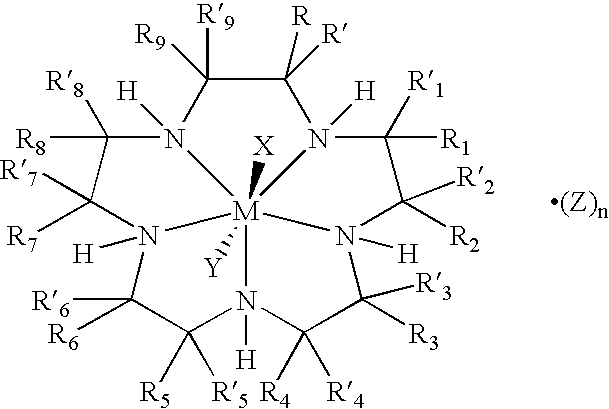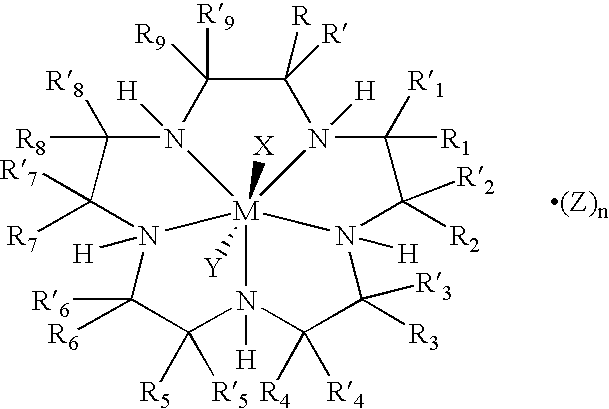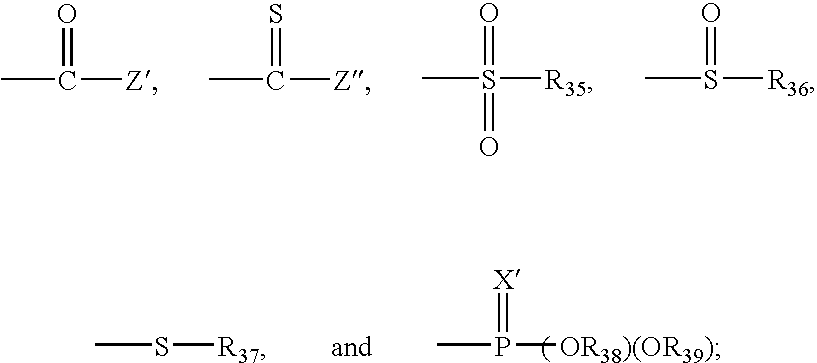Bioconjugates of metal complexes of nitrogen-containing macrocyclic ligands
a technology of macrocyclic ligands and bioconjugates, which is applied in the field of compounds, can solve the problems of small amounts of free lanthanides being released, the timing of injection is extremely critical, and the possibility remains, and achieves the effect of oxidative stability and hydrogen bonding
- Summary
- Abstract
- Description
- Claims
- Application Information
AI Technical Summary
Benefits of technology
Problems solved by technology
Method used
Image
Examples
example 1
A. Synthesis of N-(p-toluenesulfonyl)-(R,R)-1,2-diaminocyclohexane
[0090]To a stirred solution of (R,R)-1,2-diaminocyclohexane (300 g, 2.63 mole) in CH2Cl2 (5.00 l) at −10° C. was added a solution of p-toluenesulfonylchloride (209 g, 1.10 mole) in CH2Cl2 (5.00 l) dropwise over a 7 h period, maintaining the temp at −5 to −10° C. The mixture was allowed to warm to room temp while stirring overnight. The mixture was concentrated in vacuo to a volume of 3 l and the white solid was removed by filtration. The solution was then washed with H2O (10×1 l) and was dried over MgSO4. Removal of the solvent in vacuo gave 286 g (97.5% yield) of the product as a yellow crystalline solid: 1H NMR (CDCl3) δ 0.98-1.27 (m, 4H), 1.54-1.66 (m, 2H), 1.81-1.93 (m, 2H), 2.34 (dt, J=4.0, 10.7 Hz, 1H), 2.42 (s, 3H), 2.62 (dt, J=4.2, 9.9 Hz, 1H), 7.29 (d, J=8.1 Hz, 2H), 7.77 (d, J=8.3 Hz, 2H); MS (LRFAB-DTT-DTE) m / z 269 [M+H]+.
B. Synthesis of N-(p-toluenesulfonyl)-N′-(Boc)-(R,R)-1,2-diaminocyclohexane
[0091]To a ...
example 2
[0106]Relaxivity measurements of the complex of Example 1 was determined.
[0107]Proton relaxation times (T1) of the sample in 100 mM Hepes buffer, pH=7.4, at 40° C. were determined from a monoexponential curve fit obtained from inversion-recovery pulse sequences (180°-τ-90°) with a Bruker PC 120 / 125 / 10 VTs NMR process analyzer. The spectrometer was calibrated for each sample to assure accurate duration of 90° and 180° radio frequency pulses and appropriate magnetic field strength to match the 20 MHz system operating frequency. The relaxivity (R1) was obtained from the slope of a plot of 1 / T1 versus the concentration of paramagnetic compound.
[0108]The relaxation time (T2) of each sample in 100 mM Hepes buffer, pH=7.4, was measured at 40° C. using a Carr-Purcel-Meiboom-Gill pulse sequence on the same Bruker instrument. The relaxivity (R2) was obtained from a plot of 1 / T2 versus the concentration of the paramagnetic compound.
[0109]The relaxivity of the complex of Example 1 is as follows...
PUM
 Login to View More
Login to View More Abstract
Description
Claims
Application Information
 Login to View More
Login to View More - R&D
- Intellectual Property
- Life Sciences
- Materials
- Tech Scout
- Unparalleled Data Quality
- Higher Quality Content
- 60% Fewer Hallucinations
Browse by: Latest US Patents, China's latest patents, Technical Efficacy Thesaurus, Application Domain, Technology Topic, Popular Technical Reports.
© 2025 PatSnap. All rights reserved.Legal|Privacy policy|Modern Slavery Act Transparency Statement|Sitemap|About US| Contact US: help@patsnap.com



